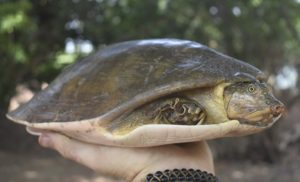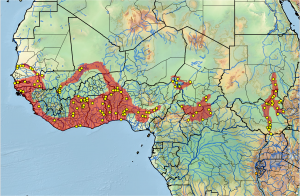Cyclanorbis senegalensis, 114
Cyclanorbis senegalensis (Duméril and Bibron 1835) –
Sahelian Flapshell Turtle, Senegal Flapshell Turtle
Pearson McGovern1, Tomas Diagne1, Lamine Diagne2,
Luca Luiselli3,4,5, and Peter A. Meylan6
1African Chelonian Institute, BP 80 Joal, Thies 23015, Senegal
[[email protected], [email protected], [email protected]];
2Village des Tortues, Noflaye, Dakar, Senegal [[email protected]];
3Institute for Development, Ecology, Conservation & Cooperation, via G. Tomasi di Lampedusa 33,
I-00144 Rome, Italy [[email protected]; [email protected]];
4Department of Zoology, University of Lomé, Togo;
5Department of Environmental and Applied Biology, Rivers State University of Science and Technology,
P.M.B. 5080, Port Harcourt, Nigeria;
6Natural Science, Eckerd College, 4200 54th Ave. South,
St. Petersburg, Florida 33711 USA [[email protected]]
Summary. – The Sahelian Flapshell Turtle, Cyclanorbis senegalensis (family Trionychidae) is the most widely distributed of the African members of the trionychid subfamily Cyclanorbinae, occurring across the sub-Saharan Sahel region from Senegal to Ethiopia. It is a moderate sized, sexually size-dimorphic freshwater turtle with females (curved carapace length [CCL] up to ca. 38 cm) much larger than males (CCL up to ca. 19 cm). There are only minimal data available concerning the preferred habitats, natural history, and ecology of African cyclanorbines, including this species, but it apparently prefers medium sized rivers (5–25 m river-bed width) or waterbodies off main river channels with at least sparse emergent vegetation, grassy, semi- or highly-vegetated banks, and predominantly muddy bottoms. Nesting appears to occur primarily in April and the clutch size may be small (only a single clutch of 6 round eggs measuring 36 mm in diameter has been reported); hatchlings measure ca. 41–54 mm straight carapace length. Cyclanorbis senegalensis and other African softshell turtles are frequently used by local people for food, and when coupled with habitat degradation, the potential for local extirpation and increased global vulnerability of this species is of concern.
Distribution. – Apparently disjunct and fragmented distribution across the sub-Saharan Sahel from Senegal in the west to western Ethiopia in the east. Benin, Burkina Faso, Cameroon, Central African Republic, Chad, Ethiopia, Gambia, Ghana, Guinea, Guinea-Bissau, Ivory Coast (Côte d’Ivoire), Liberia, Mali, Mauritania, Niger, Nigeria, Senegal, Sierra Leone, South Sudan, Sudan, Togo.
Synonymy. – Cryptopus senegalensis Duméril and Bibron 1835, Emyda senegalensis, Cyclanosteus senegalensis, Cyclanorbis petersii Gray 1854, Cyclanosteus petersii, Cycloderma petersii, Cycloderma senegalense Duméril 1861 (nomen novum), Tetrathyra baikii Gray 1865a, Cyclanosteus senegalensis callosa Gray 1865b, Cyclanosteus senegalensis equilifera Gray 1865b, Cyclanosteus senegalensis normalis Gray 1865b, Tetrathyra vaillantii Rochebrune 1884.
Subspecies. – None currently recognized.
Status. – IUCN 2021 Red List Status: Vulnerable (VU A2bcd+4bcd, assessed 2016); CITES: Appendix II.
Citation:
McGovern, P., Diagne, T., Diagne, L., Luiselli, L., and Meylan, P.A. 2021. Cyclanorbis senegalensis (Duméril and Bibron 1835) – Sahelian Flapshell Turtle, Senegal Flapshell Turtle. In: Rhodin, A.G.J., Iverson, J.B., van Dijk, P.P., Stanford, C.B., Goode, E.V., Buhlmann, K.A., and Mittermeier, R.A. (Eds.). Conservation Biology of Freshwater Turtles and Tortoises: A Compilation Project of the IUCN/SSC Tortoise and Freshwater Turtle Specialist Group. Chelonian Research Monographs 5(15):114.1–10. doi: 10.3854/crm.5.114.senegalensis.v1.2021; www.iucn-tftsg.org/cbftt/.
Download pdf
Adobe Acrobat 6.0 or later required)
An adult female Cyclanorbis senegalensis caught in the Gambia River near the village of Soucouta, Senegal. The prenuchal in this individual is visible as a small swelling in the carapace just above the eye; 33.8 cm curved carapace length, 24.0 cm curved bony carapace length.
Photo by Pearson McGovern.
Distribution:
Distribution of Cyclanorbis senegalensis in sub-Saharan Africa. Yellow dots = museum and literature occurrence records of native populations based on Iverson (1992), TTWG (2017, 2021), and authors’ more recent data; orange dot = probable trade or misidentified specimen; red shading = presumed native historic indigenous range. Distribution based on GIS-defined level 12 HUCs (hydrologic unit compartments) constructed around verified localities and then adding HUCs that connect known point localities in the same watershed or physiographic region, and similar habitats and elevations as verified HUCs (Buhlmann et al. 2009; TTWG 2017, 2021) and adjusted based on authors’ data.










